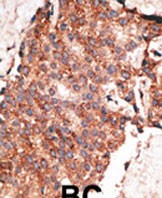Bmp1 Antibody (C-term)
Purified Rabbit Polyclonal Antibody (Pab)
- 产品详情
- 文献引用 : 1
- 实验流程
- 背景知识
Application
| IHC-P, WB, E |
|---|---|
| Primary Accession | P13497 |
| Other Accession | P98063 |
| Reactivity | Human, Mouse |
| Host | Rabbit |
| Clonality | Polyclonal |
| Isotype | Rabbit IgG |
| Calculated MW | 111249 Da |
| Antigen Region | 957-986 aa |
| Gene ID | 649 |
|---|---|
| Other Names | Bone morphogenetic protein 1, BMP-1, Mammalian tolloid protein, mTld, Procollagen C-proteinase, PCP, BMP1, PCOLC |
| Target/Specificity | This Bmp1 antibody is generated from rabbits immunized with a KLH conjugated synthetic peptide between 957-986 amino acids from the C-terminal region of human Bmp1. |
| Dilution | IHC-P~~1:100~500 WB~~1:1000 E~~Use at an assay dependent concentration. |
| Format | Purified polyclonal antibody supplied in PBS with 0.09% (W/V) sodium azide. This antibody is prepared by Saturated Ammonium Sulfate (SAS) precipitation followed by dialysis against PBS. |
| Storage | Maintain refrigerated at 2-8°C for up to 2 weeks. For long term storage store at -20°C in small aliquots to prevent freeze-thaw cycles. |
| Precautions | Bmp1 Antibody (C-term) is for research use only and not for use in diagnostic or therapeutic procedures. |
| Name | BMP1 |
|---|---|
| Synonyms | PCOLC |
| Function | Metalloprotease that plays key roles in regulating the formation of the extracellular matrix (ECM) via processing of various precursor proteins into mature functional enzymes or structural proteins (PubMed:33206546). Thereby participates in several developmental and physiological processes such as cartilage and bone formation, muscle growth and homeostasis, wound healing and tissue repair (PubMed:32636307, PubMed:33169406). Roles in ECM formation include cleavage of the C-terminal propeptides from procollagens such as procollagen I, II and III or the proteolytic activation of the enzyme lysyl oxidase LOX, necessary to formation of covalent cross- links in collagen and elastic fibers (PubMed:31152061, PubMed:33206546). Additional substrates include matricellular thrombospondin-1/THBS1 whose cleavage leads to cell adhesion disruption and TGF-beta activation (PubMed:32636307). |
| Cellular Location | Golgi apparatus, trans-Golgi network. Secreted, extracellular space, extracellular matrix. Secreted. Note=Co-localizes with POSTN in the Golgi. |
| Tissue Location | Ubiquitous. |
For Research Use Only. Not For Use In Diagnostic Procedures.

Provided below are standard protocols that you may find useful for product applications.
BACKGROUND
The BMP1 locus encodes a protein that is capable of inducing formation of cartilage in vivo. Although other bone morphogenetic proteins are members of the TGF-beta superfamily, BMP1 encodes a protein that is not closely related to other known growth factors. BMP1 protein and procollagen C proteinase (PCP), a secreted metalloprotease requiring calcium and needed for cartilage and bone formation, are identical. PCP or BMP1 protein cleaves the C-terminal propeptides of procollagen I, II, and III and its activity is increased by the procollagen C-endopeptidase enhancer protein. The BMP1 gene is expressed as alternatively spliced variants that share an N-terminal protease domain but differ in their C-terminal region.
REFERENCES
Leighton, M., et al., J. Biol. Chem. 278(20):18478-18484 (2003).
Hartigan, N., et al., J. Biol. Chem. 278(20):18045-18049 (2003).
Garrigue-Antar, L., et al., J. Biol. Chem. 277(45):43327-43334 (2002).
Rattenholl, A., et al., J. Biol. Chem. 277(29):26372-26378 (2002).
Janitz, M., et al., J. Mol. Med. 76(2):141-146 (1998).
终于等到您。ABCEPTA(百远生物)抗体产品。
点击下方“我要评价 ”按钮提交您的反馈信息,您的反馈和评价是我们最宝贵的财富之一,
我们将在1-3个工作日内处理您的反馈信息。
如有疑问,联系:0512-88856768 tech-china@abcepta.com.






















 癌症的基本特征包括细胞增殖、血管生成、迁移、凋亡逃避机制和细胞永生等。找到癌症发生过程中这些通路的关键标记物和对应的抗体用于检测至关重要。
癌症的基本特征包括细胞增殖、血管生成、迁移、凋亡逃避机制和细胞永生等。找到癌症发生过程中这些通路的关键标记物和对应的抗体用于检测至关重要。 为您推荐一个泛素化位点预测神器——泛素化分析工具,可以为您的蛋白的泛素化位点作出预测和评分。
为您推荐一个泛素化位点预测神器——泛素化分析工具,可以为您的蛋白的泛素化位点作出预测和评分。 细胞自噬受体图形绘图工具为你的蛋白的细胞受体结合位点作出预测和评分,识别结合到自噬通路中的蛋白是非常重要的,便于让我们理解自噬在正常生理、病理过程中的作用,如发育、细胞分化、神经退化性疾病、压力条件下、感染和癌症。
细胞自噬受体图形绘图工具为你的蛋白的细胞受体结合位点作出预测和评分,识别结合到自噬通路中的蛋白是非常重要的,便于让我们理解自噬在正常生理、病理过程中的作用,如发育、细胞分化、神经退化性疾病、压力条件下、感染和癌症。







